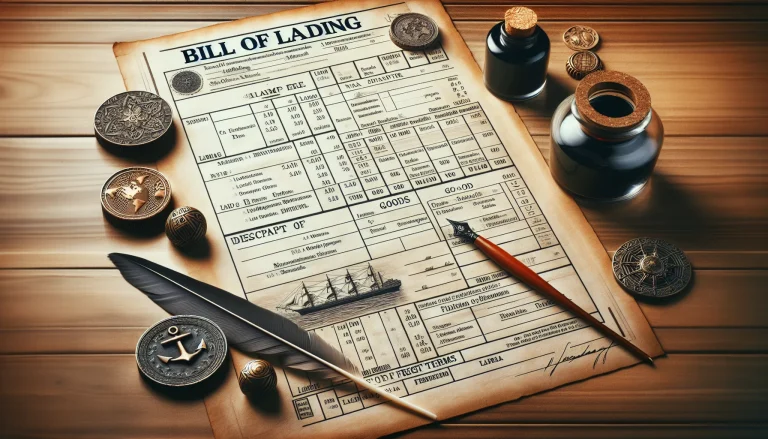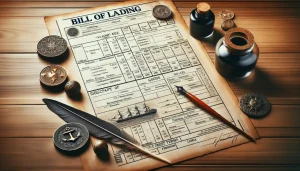“Bill of Lading, often dismissed as shipping jargon, is transforming business logistics and how.
In the labyrinth of international export, understanding the ‘Bill of Lading’ could be the difference between seamless cargo delivery and a logistical nightmare. This one document, seemingly complex, is a powerful tool to expedite your business shipping processes, providing an unparalleled strategic edge.
Your bottom line benefits. Profits swell. Your business sails smoothly.
So, what is a ‘Bill of Lading’ for business owners, you may ask? Let’s demystify this game-changer in the shipping landscape together.”
Unveiling the Power of Bill of Lading for Your Business
The Role of Bill of Lading in Shipping
The Bill of Lading (BoL) is like a golden key that unlocks the complex door of the shipping industry. It is a legally binding document issued by a carrier to a shipper that serves multiple crucial purposes. Understanding the chain of custody process in shipping is essential – discover how a comprehensive Bill of Lading management can enhance the security and traceability of your cargo.
It is proof of a contract of carriage – the contractual agreement between the company shipping the goods and the transport company or carrier.
The BoL is a receipt for goods, an acknowledgment issued by a carrier stating that certain goods have been received for transport.
The highlight of a BoL? It’s a document of title. Intriguing, right? This essentially means it provides proof of ownership of the goods in transport. If you’re Jane and you’re sending an antique vase to John, the BoL legally proves that the vase is indeed John’s, the moment it’s loaded and the BoL is signed.
To put it simply, think of BoL as the backbone of the shipping industry. It supports transactions, ensures transparency, and fosters trust between parties, making shipping a smooth sail, even amidst stormy business seas.
How a Straight or Ocean Bill of Lading Protects Your Business
Companies that incorporate BoL into their operations tap into an array of benefits. The chief one is protection – from legal perspectives and business standpoints.
A BoL shields businesses from the daunting world of disputes and claims. Remember the antique vase? If it arrives at John’s all cracked and chipped, the BoL stands witness as John seeks compensation from the carrier for the damaged goods.
Moreover, it protects against fraud. The importance of this can’t be overlooked, especially in these digital times where transactions are no longer confined to business hours or geographic boundaries. The BoL ensures that Jane can’t claim the vase was never sent, nor can John say he never received it.
Additionally, it safeguards the interest of third parties involved. It may be the case that the vase is sold while in transit. Through the transferable Bill of Lading, the new owner acquires the right to the goods, while Jane’s claim to the goods ends once the original Bill is transferred.
The unsung hero of the shipping industry, the Bill of Lading offers more than meets the eye, extending protection to parties involved and ensuring transactions run as smoothly as possible in unpredictable business waters.
In essence, consider the Bill of Lading as your business’s trusted shield, offering you the confidence to navigate your way through the complex world of shipping and handling. Discover how each stage, from the initial mile to the mid-journey leg, plays a pivotal role, especially the central segment, in fortifying your shipping operations and enhancing the robustness of your Bill of Lading.

Join Metrobi driver network and earn up to $1,200 / week
With Metrobi, you can deliver for local businesses and make up to $1,200 per week.
Exploring the Different Types of Bill of Lading
Straight Bill of Lading
A straight Bill of Lading, also referred to as a non-negotiable Bill of Lading, is a legally binding document laying the foundation for a swift and straightforward shipment process. Predominantly, it is used when payment for the goods is received before shipment. This legal document dictates that the carrier must deliver goods straight to the consignee stated in the bill.
The key feature of a straight Bill of Lading is its non-negotiability, meaning it can’t be transferred to a third party. This characteristic brings about simplicity and clarity, mitigating risks of misunderstanding or misdirection during shipping. It serves to ensure timely delivery as no changes in parties involved can delay the shipping process.
Order Bill of Lading
The order Bill of Lading differs from the straight Bill in its negotiability, rendering it instrumental in facilitating transactions where payment takes place after the shipment. The goods are delivered to the order or the endorsement of a stated party. Charter party bill plays a crucial role in international trade, particularly where there are layers of buying and selling before the goods reach their final destination.
Order Bill of Lading forms dominate in scenarios where shipments traverse extensive distances, and credit financing or letters of credit are involved. Its negotiability offers increased flexibility as it allows consignment redirection or transfer. Thus, it represents an asset to its holder and can be sold, bought, or used as collateral.
Seaway Bill of Lading
A seaway Bill of Lading, often reserved for trusted parties, is a receipt issued by the carrier, acknowledging the onboard acceptance or receipt of goods. Unlike the two previous types, this bill doesn’t confer ownership, making it non-negotiable and non-transferable. It’s typically employed when there is a high level of trust between the shipper and the consignee, or when goods have been paid for in advance.
The seaway Bill streamlines the shipping process, as it doesn’t require physical presentation for the goods to be delivered. Its digital-friendly nature promotes swift electronic transactions, accelerating the shipping process. By eliminating the need for physical exchanges of documents, it contributes towards a more eco-friendly and efficient logistic sector.
Having outlined these three types of Bills of Lading, we comprehend how each, with its unique features, streamlines and shapes the shipping and logistics sector. They are not just pieces of paper, but powerful instruments driving the world trade logistics.
Step-by-Step Guide to Creating a Bill of Lading
Step 1: Gather Necessary Information
Compiling the correct documents is a building block of the Bill of Lading creation process. The first step is to assemble all data, which includes the following:
Shipper and Consignee Details
This entails the legal names, complete addresses, and contact details of both the sender and receiver of the cargo. Transposing errors can lead to problematic shipping complications, a pain no business wants to experience.
Freight information
It’s imperative to have a detailed, precise description of the goods set for shipping. Depending on the type of commodities, this includes weight, dimensions, and unit count.
Step 2: Choose the Right Type of Bill of Lading
Choosing the right kind of Bill of Lading requires an understanding of the nuances of each available option. Some factors to consider while selecting the appropriate type include:
The type of goods being shipped and their destination influence the form used. Hazardous materials, for instance, require specific forms to comply with safety regulations. Understanding the intricacies of vehicle idling can also play a crucial role in ensuring the safe transportation of goods, according to industry specialists. Learn how appropriate idling strategies can enhance the safety of hazardous material transport.
Each type of Bill offers distinctive mechanisms for risk mitigation. For instance, a Straight Bill of Lading protects sellers, whereas an Order Bill benefits the buyers.
Step 3: Fill Out the Bill of Lading Form
With all the information at hand, the next phase is to fill out the form correctly:
Fields like shipper, consignee, and freight details are obligatory and should be filled as accurately as possible to prevent freight mishaps.
The Bill of Lading ought to be endorsed by an authorized representative of the shipper, freight forwarder, carrier, and consignee. This endorsement makes the document legally binding.
Understanding the Legal Implications of a Bill of Lading
Bill of Lading as a Contract of Carriage
Every business transaction thrives on clarity of terms, and shipping is no exception. A Bill of Lading (BoL) is an instrument of certainty in its role as a contract of carriage.
When you have goods to send, whether it’s a shipment of books or a fleet of cars, you enter into a binding agreement with a carrier – such as a shipping line or freight company. This agreement is the Bill of Lading. The BoL details specific terms like the nature of freight classification, of goods, destination of delivery, and cost of carriage among other essential considerations. Wondering how to enhance the efficiency of your shipping method? Discover the benefits of delivery via pallets and how it can make a significant difference in your logistics strategy.
This critical document lays out each party’s rights and obligations and serves as the blueprint for the entirety of the transit process, reducing ambiguity and preventing disputes from arising in the course of business.
Bill of Lading as a Receipt of Goods
Beyond its role as a contract, a BoL also functions as a formal receipt. Following a thorough check of goods─ volume, quality, and condition─ the carrier then acknowledges receipt by issuing the BoL to the shipper. This is a pivotal point in the shipping process; it signifies the transfer of responsibility to transport the goods from the shipper to the carrier. The carrier is now accountable for delivering the goods in the condition they were received.
Without this receipt, claims, subsequent sales, or even financing of goods in transit would prove onerous, if not impossible. A BoL eases these processes, providing businesses with a verifiable stamp of authenticity that the goods were indeed received for carriage.
Bill of Lading as a Document of Title
A less known function of the BoL is in its capacity as a document of title. Essentially, a document of title grants the holder─ the consignee or the legally authorized person─ ownership of the goods being shipped. This is carried out by endorsing the BoL.
In the bustle of trade, where goods may change hands multiple times whilst in transit, the value of the BoL as a document of title cannot be overstated. This value extends to multifaceted scenarios such as where goods are sold while in transit, and the endorsed BoL is forwarded to the new buyer.
Ownership rights bestowed by the BoL are concrete. They’re enabling for shippers and consignees alike, bringing a layer of depth to business transactions that few other documents can.
While a BoL wears three hats, each is crucial to logistical operations in its own right, providing the necessary scaffolding for businesses to conduct their dealings securely and efficiently.
The Role of Bill of Lading in International Trade
Moving on from the legal implications of a Bill of Lading, now we shift our focus to its pivotal role in international trade.
Facilitating International Trade Transactions
It isn’t an exaggeration to label the Bill of Lading as the lifeblood of international trade transactions. These valuable documents provide a common one-stop communication channel among all parties involved in a shipment. Uncover how integrating backhaul trucking strategies enhances international trade efficiency by optimizing all phases of shipment, ensuring cost-effectiveness and reducing wastage in the transport chain.
It starts with the journey of an order. The moment a buyer in another country initiates an order, the seller has to coordinate with a trucker or a warehouse to move the goods to a port. And the Bill of Lading? It plays the role of a referee, ensuring every player in this game stays on track. Discover how leveraging backhaul trucking strategies can streamline your shipping process, turning the return journey into a cost-effective opportunity.
Could you imagine the chaos if there were no consistent documentation-specific guidelines to follow? Each party would be left to set up its own rules, leading to confusion, mistakes, and potentially lost shipments. Heaven forbid if there is a dispute. The Bill of Lading, in its unassuming glory, ensures order and clarity in an otherwise complex labyrinth of transactions. Dive into the digital era with electronic logging devices: Understand how these technological tools can bring accuracy and efficiency to tracking and documentation processes.
Ensuring Compliance with International Trade Laws
An essential aspect of doing business on an international scale is ensuring compliance with the relevant laws. The Bill of Lading provides a record that allows businesses to demonstrate compliance with these regulations. How’s that for an invaluable piece of paper?
Let’s talk about audits. They might not be a favorite topic, but they are an inevitable and important part of doing business. The Bill of Lading provides verifiable evidence suitable for audit trials. It outlines the exact journey of a product, helping businesses provide detailed and accurate documentation necessary for audits.
In the event of a dispute, a Bill of Lading serves as a contract of carriage and proof of receipt. It offers proof of what services were agreed upon, how they were executed, and what the outcomes were. Without you even knowing it, it’s saving you from countless headaches and potential legal pitfalls.
In the complex maze of international trade, compliance is trusted. A Bill of Lading enhances that trust by verifying that goods were loaded on board as per agreed-upon terms. It holds parties accountable, fostering an environment where businesses can trust one another and operate successfully, which is a win for everyone involved in the transaction. Discover the key principles of planning loads in international trade and ensure your goods meet compliance and safety standards.
In the cutthroat world of international trade, businesses that can show consistent compliance gain the upper hand. They can establish better relationships with everyone from clients to regulators. In essence, the Bill of Lading plays a vital role in fostering a business environment built on trust and transparency.
Now, armed with the knowledge of how a Bill of Lading facilitates international trade and ensures compliance with laws, it’s easy to see why it’s a game-changer in the shipping industry.
What is a Bill of Lading?
Defining Bill of Lading
At the intersection of trade, commerce, and law stands an essential document — the Bill of Lading. It functions as a contract between a shipper and a carrier, wherein the carrier agrees to transport goods to a designated location in exchange for a fee. This document stands as a receipt issued by the carrier once they receive the goods and provides evidence of the contract of carriage. There may be different kinds of documents, such as combined transport bill, claused bill, and inland bill.
Additionally, the Bill of Lading serves as a document of title, conferring possession rights on the holder, underscoring its significance in the shipping business.
Key Elements of a Bill of Lading
With the complexity and importance of this document in mind, a good understanding of its elements is essential.
A Bill of Lading identifies the shipper, the carrier, and the receiver or consignee. Their addresses and contact information form a critical part of this document.
Critical details about the cargo – its nature, the number of units, and any special handling instructions – all factor into the Bill of Lading.
Details of the journey, including the route of the voyage, the intended destination, and expected time frames, are also spelled out in the document.
A fully prepared Bill of Lading, rife with these key elements, stands as a robust tool in the facilitation of successfully concluded trade transactions. It carries the assurance of the carrier to the transactions and safeguards the interests of the buyer or the consignee until the delivery of the goods.
Common Mistakes to Avoid When Creating a Bill of Lading
Incomplete or Incorrect Information
Every detail in the Bill of Lading serves a purpose – from transportation specifics to legal obligations. Hence, inaccurate or missing data on it can lead to significant issues.
An incorrectly filled Bill of Lading can result in shipping disturbances due to the possibility of a wrong product, inaccurate quantity, or incorrect destination. Not only will this disrupt your operations, but it could potentially damage relationships with clients or partners because it portrays unreliable service, leading to loss of business and reputation.
Moreover, it can make it challenging to pinpoint responsibility in case of lost or damaged goods – a fundamental reason for having a Bill of Lading. Therefore, precision is critical when filling out the Bill of Lading to prevent such consequences.
Not Choosing the Right Type of Bill of Lading
Different types of Bills of Lading suit varying shipping requirements. Selecting the incorrect type can put business owners at financial risk, legal liabilities, or both.
For instance, a “received for shipment” Bill of Lading is produced when the goods are received, but not yet loaded. If a carrier instead issues an “on board” Bill of Lading – indicating goods are already on the vessel, it could lead to disputes and potential losses if the consignment gets spoiled or lost before loading.
It’s essential to understand each type’s relevance to make an informed choice, as it can help you avoid unnecessary risks associated with international trade.
Not Understanding the Legally Binding Document and Implications
A Bill of Lading is not just a document; it’s a legally binding agreement. Without a solid grasp of its legal ramifications, business owners risk running into serious problems.
One common misunderstanding is treating it merely as an inventory list, overlooking its role as evidence of the transport agreement. Consequently, any potential disputes about shipment terms or delivery conditions will lack a legally binding reference, potentially leading to costly legal battles or settlements.
Additionally, not appreciating this document’s role can lead to non-compliance with export-import laws, resulting in hefty fines or legal ramifications. Hence understanding the legal implications of a Bill of Lading goes a long way in avoiding these issues.
Sealing Your Shipping and Freight Forwarder Success
From enhancing goods delivery transparency to minimizing shipment disputes, the Bill of Lading indeed is more than just a document; it’s an invaluable asset for shipping businesses. It not only organizes the shipping journey but also safeguards the interests of all parties involved.
Here’s your next step – implement a detailed Bill of Lading system and see your cargo management becoming significantly streamlined.
Now, a question for you: have you experienced a specific scenario where the Bill of Lading rescued an otherwise problem-ridden freight shipment? Share your BoL success story with us!
Remember, successful shipping is all in the details. And maybe in the margins too. After all, every shipment is a story waiting to be told, and with a well-executed Bill of Lading, you’re always the author in control.





























